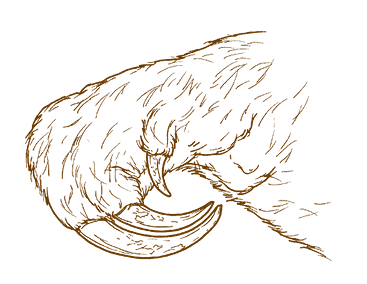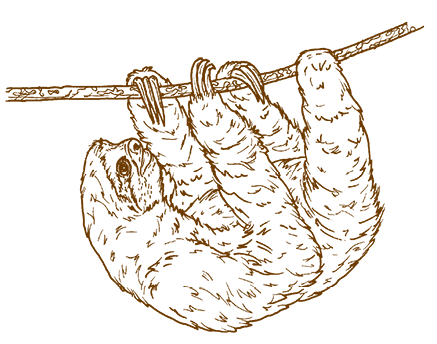
Giant Anteater
Myrmecophaga tridactyla
(murm-e-cof-aga tri-dak-til-a)

Giant anteaters have no teeth, but they do have incredibly long snouts and fast-moving tongues. Measuring 6.5 feet (2 m) from head to tail and weighing up to 145 pounds (65 kg), these insect-eaters have long, sharp claws, which they use to eat their favorite foods: ants and termites. First, they slash holes in an ant or termite mound. Then they shove their tubular noses into the hole and use their 2-foot-long (60 cm) tongues to collect up to 35,000 ants and termites a day! How do they do this? Their tongues are covered with sticky saliva and tiny, backward-facing barbs that trap the insects.
They also have a large bushy tail that can make it hard to tell which end is which! Their tail also comes in handy as a blanket in the colder months and a source of shade in the hotter months.

Where They Live
Sadly, giant anteaters are now extinct in Guatemala and Belize, but they can still be found in other parts of Central and South America, such as Argentina, Paraguay, and Bolivia. They enjoy a variety of habitats, but are usually found in grasslands, forests, and plantations.
What They Eat
Since they have to eat such an enormous quantity of ants and termites every day just to survive, giant anteaters have developed the ability to move their tongues as fast as 160 times a minute! (But that’s the only thing about them that moves quickly—like their relatives the sloths, they conserve their energy by keeping their other movements slow.) Amazingly, giant anteaters aren’t immune to ant bites! That’s part of why they have to eat so quickly—they spend only a minute or so slurping up ants at each mound.
Close Relations
Anteaters, armadillos, and sloths are all part of a group of mammals called Xenarthra. These mammals have certain key features in common—for example, they all have razor-sharp claws.

Conservation Status
Vulnerable
The anteater has survived for 25 million years on earth, yet in the past 10 years, it’s started to disappear at a rapid rate because of land loss, poaching, and car accidents.
In places like Brazil, people catch and kill the giant anteater for its supposed medicinal uses, as well as for food and leather products. Unfortunately, there may be only about 5,000 left in the wild.

Fun Facts
